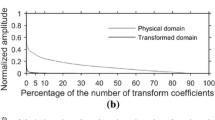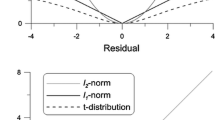Abstract
In the inversion part of the full-waveform inversion (FWI) that brings high resolution in finding a convergence point in the model space, a localized numerical optimization technique reduces the objective function employing the \(\ell_{2}\) norm in a least-squares approach. Given the \(\ell_{2}\) norm's vulnerability to outliers and noise, this strategy might frequently yield imprecise imaging outcomes. Consequently, it's essential to introduce a novel regulatory approach that incorporates a more applicable form of relaxation to address the issue of overfitting, specifically, the K-support norm, characterized by its more logical and stringent restrictions. Unlike the least-squares method that targets the \(\ell_{2}\) norm reduction, the \(\ell_{1}\) norm is celebrated for its ability to ensure sparsity, durability, and superior noise reduction capabilities; thus, we consider a new regularization form, the K-support norm, which combines the \(\ell_{2}\) and the \(\ell_{1}\) norms in minimization. Subsequently, a quadratic penalty approach is utilized to expedite the convergence process and prevent entrapment in local minima, linearizing the nonlinear issue to reduce computational demands. This study presents the K-support norm concept, incorporating it with the quadratic penalty approach to enhance both convergence speed and resilience to ambient noise. In the numerical demonstration, three synthetic models are evaluated to demonstrate the K-support norm's superiority over Tikhonov regularization using two distinct noise data sets. Experimental results indicate that the modified FWI improves inversion accuracy by enhancing lateral resolution in deeper parts even with data with a low signal-to-noise ratio.























Similar content being viewed by others
Data Availability
The model used in this article is available in Zenodo. The code underlying this paper will be shared on reasonable request to the corresponding author.
References
Aghamiry, H. S., Gholami, A., & Operto, S. (2019a). Improving full-waveform inversion by wavefield reconstruction with the alternating direction method of multipliers. Geophysics, 84, R139–R162.
Aghamiry, H. S., Gholami, A., & Operto, S. (2019b). Compound regularization of full-waveform inversion for imaging piecewise media. IEEE Transactions on Geoscience and Remote Sensing, 58, 1192–1204.
Aghamiry, H. S., Gholami, A., & Operto, S. (2020). Multiparameter wavefield reconstruction inversion for wave speed and attenuation with bound constraints and total variation regularization. Geophysics, 85, R381–R396.
Aghamiry, H. S., Gholami, A., & Operto, S. (2021). On efficient frequency-domain full-waveform inversion with extended search space. Geophysics, 86, R237–R252.
Aghamiry, H. S., Gholami, A., & Operto, S. (2022). ADMM-based full-waveform inversion for micro seismic imaging. Geophysical Journal International., 228, 259–274.
Aghazade, K., Gholami, A., Aghamiry, H. S., & Operto, S. (2022). Anderson-accelerated augmented Lagrangian for extended waveform inversion. Geophysics, 87, R79–R91.
Argyriou, A., Foygel, R., & Srebro, N. (2012). Sparse prediction with the k-Support Norm. Advances in neural information processing systems 25. Part of advances in neural information processing systems 25 (NIPS 2012). In Proceedings of the 25th international conference on neural information processing systems, (Vol. 1, pp. 1457–1465). https://papers.nips.cc/paper_files/paper/2012/hash/99bcfcd754a98ce89cb86f73acc04645-Abstract.html.
Bai, L., & Liang, J. (2020). Sparse subspace clustering with entropy-norm. In: The 37th International Conference on Machine Learning.
Belilovsky, E., Argyriou, A., Varoquaux, G., & Blaschko, M. (2015). Convex relaxations of penalties for sparse correlated variables with bounded total variation. Machine Learning, 100, 533–553.
Billette, F.J., & Brandsberg-Dahl, S. (2005). The 2004 BP velocity benchmark. In: 67th EAGE Conference and Exhibition 2005.
Boyd, S., Parikh, N., Chu, E., Peleato, B., & Eckstein, J. (2011). Distributed optimization and statistical learning via the alternating direction method of multipliers. Foundations and Trends Machine Learning, 3, 1–122.
Boyd, S. P., & Vandenberghe, L. (2004). Convex Optimization. Cambridge University Press.
Brossier, R., Operto, S., & Virieux, J. (2009). Robust elastic frequency-domain full-waveform inversion using the L1 norm. Geophysical Research Letters, 36, L20310.
Brossier, R., Operto, S., & Virieux, J. (2010). Which data residual norm for robust elastic frequency-domain full waveform inversion? Geophysics, 75, R37–R46.
Choi, Y., & Alkhalifah, T. (2012). Application of multi-source waveform inversion to marine streamer data using the global correlation norm. Geophysical Prospecting, 60, 748–758.
de Ridder, S., & Dellinger, J. (2011). Ambient seismic noise eikonal tomography for near-surface imaging at Valhall. The Leading Edge, 30, 506–512.
Donoho, D. L. (2006). For most large underdetermined systems of linear equations the minimal 1-norm solution is also the sparsest solution. Communications on Pure and Applied Mathematics, 59, 797–829.
Fleet, D., Pajdla, T., Schiele, B., & Tuytelaars, T. (2014). Computer Vision -- ECCV 2014: 13th European Conference, Zurich, Switzerland, September 6-12, 2014, Proceedings, Part I. Springer.
Gambella, C., & Simonetto, A. (2020). Multiblock ADMM heuristics for mixed-binary optimization on classical and quantum computers. IEEE Transactions on Quantum Engineering, 1, 1–22.
Hastie, T., Friedman, J., & Tibshirani, R. (2009). The elements of statistical learning: Data mining, inference, and prediction. Springer.
Haury, A. C. (2012). Feature selection from gene expression data: molecular signatures for breast cancer prognosis and gene regulation network inference (Doctoral dissertation, Ecole Nationale Supérieure des Mines de Paris).
Koh, K., Kim, S. J., & Boyd, S. (2007). An interior-point method for large-scale l1-regularized logistic regression. Journal of Machine Learning Research, 8, 1519–1555.
Kwak, N. (2008). Principal component analysis based on L1-norm maximization. IEEE Transactions on Pattern Analysis and Machine Intelligence, 30, 1672–1680.
Lai, H., Pan, Y., Lu, C., Tang, Y., & Yan, S. (2014). Efficient k-support matrix pursuit. In: European Conference on Computer Vision.
Lailly, P., & Bednar, J. (1983). The seismic inverse problem as a sequence of before stack migrations. In Conference on inverse scattering: theory and application, (pp. 206–220).
Loris, I., Nolet, G., Daubechies, I., & Dahlen, F. A. (2007). Tomographic inversion using ℓ1-norm regularization of wavelet coefficients. Geophysical Journal International, 170, 359–370.
McDonald, A. M., Pontil, M., & Stamos, D. (2014). Spectral k-support norm regularization. Advances in neural information processing systems, 27. Part of advances in neural information processing systems 27 (NIPS 2014). In Proceedings of the 27th international conference on neural information processing systems, (Vol. 2, pp. 3644–3652). https://papers.nips.cc/paper_files/paper/2014/hash/cb79f8fa58b91d3af6c9c991f63962d3-Abstract.html.
Pratt, R. G. (1999). Seismic waveform inversion in the frequency domain, Part 1: Theory and verification in a physical scale model. Geophysics, 64, 888–901.
Ramani, S., & Fessler, J. A. (2011). Parallel MR image reconstruction using augmented lagrangian methods. IEEE Transactions on Medical Imaging, 30, 694–706.
Schmidt, M. (2005). Least Squares Optimization with L1-Norm Regularization. CS542B Project Report, 504, 195–221.
Sirgue, L., & Pratt, R. G. (2004). Efficient waveform inversion and imaging: A strategy for selecting temporal frequencies. Geophysics, 69, 231–248.
Sun, B., & Alkhalifah, T. (2018). Mitigate cycle skipping in FWI: A generalized instanatenous travel-time approach. 80th EAGE Conference and Exhibition 2018.
Tarantola, A. (1984). Inversion of seismic reflection data in the acoustic approximation. Geophysics, 49, 1259–1266. https://doi.org/10.1190/1.1441754.
van Leeuwen, T., & Herrmann, F. J. (2013). Mitigating local minima in full-waveform inversion by expanding the search space. Geophysical Journal International, 195, 661–667.
van Leeuwen, T., & Herrmann, F. J. (2015). A penalty method for PDE-constrained optimization in inverse problems. Inverse Problems, 32, 015007.
Virieux, J., & Operto, S. (2009). An overview of full-waveform inversion in exploration geophysics. Geophysics, 74, WCC1–WCC26.
Wang, Y., Yin, W., & Zeng, J. (2019). Global convergence of ADMM in nonconvex nonsmooth optimization. Journal of Scientific Computing, 78, 29–63.
Warner, M., & Guasch, L. (2016). Adaptive waveform inversion: Theory. Geophysics, 81, R429–R445.
Wong, R. T. (1984). A dual ascent approach for steiner tree problems on a directed graph. Mathematical Programming, 28, 271–287.
Xu, H., Caramanis, C., & Mannor, S. (2012). Sparse algorithms are not stable: A no-free-lunch theorem. IEEE Transactions on Pattern Analysis and Machine Intelligence, 34, 187–193.
Zhong, F., & Zhang, J. (2013). Linear discriminant analysis based on L1-norm maximization. IEEE Transactions on Image Processing, 22, 3018–3027.
Funding
The study was funded by the education and research budget from the University.
Author information
Authors and Affiliations
Contributions
Jiahang Li performed the methodology, formal analysis and wrote the manuscript; Hitoshi Mikada and Junichi Takekawa performed the review & editing and supervision
Corresponding author
Ethics declarations
Competing interests
The authors declare no competing interests.
Conflict of Interest
The authors declare that they have no conflict of interest.
Additional information
Publisher's Note
Springer Nature remains neutral with regard to jurisdictional claims in published maps and institutional affiliations.
Appendix A. Wavefield-Reconstruction Inversion (WRI)
Appendix A. Wavefield-Reconstruction Inversion (WRI)
Wave equation FWI algorithm based on the penalty function is proposed by van Leeuwen and Herrmann proposed.
The regularization term of PDE constrained form can be expressed as follows:
where \(\left\| { \, \, } \right\|_{2}^{2}\) is the \(\ell_{2}\) norm, and the \({\mathbf{M}} \in {\mathbb{R}}^{{{\mathcal{N}} \times 1}}\) is the model parameters; \({\mathbb{R}}\) is the regularization function, contains preliminary information about model parameters, \({\mathbf{X}} \in {\mathbb{R}}^{{{\mathcal{N}} \times 1}}\) represents the wavefield, \({\mathbf{D}} \in {\mathbb{R}}^{{{\mathcal{M}} \times 1}}\) is the recorded seismic data, \({\mathbf{S}} \in {\mathbb{R}}^{{{\mathcal{N}} \times 1}}\) is the source term, and the linear observation operator \({\mathbf{A}} \in {\mathbb{R}}^{{{\mathcal{M}} \times {\mathcal{N}}}}\) sampling \({\mathbf{X}}\) at the receiver positions.
From the mathematical point of view, the most appropriate way to solve this type of constrained optimization problem is in the form of a Lagrangian function:
where \({\mathbf{V}} = \left[ {{\mathbf{V}}_{1} ;{\mathbf{V}}_{2} ; \ldots } \right]\). The \({\mathbf{V}}\) represents the Lagrange multiplier. The advantage of using the Lagrange function is that after iterative optimization, new fitting data, forward results, and an adjoint matrix will be obtained simultaneously, which avoids the need for an explicit solution in the optimization process of conventional FWI, which means that the wavefield reconstruction inversion algorithm obtains a solution consistent with augmented wave equation term.
Since the model parameter \({\mathbf{C}}\) based on the PDE operator may converge to an approximate minimum value when the start model is not ideal, therefore, we can redefine the original constrained problem as a quadratic penalty problem (van Leeuwen & Herrmann, 2013):
With the form of a quadratic penalty term, the original full space-constrained form can be turned into a double penalty term form, reducing the complexity of the algorithm while improving the ability of FWI to converge to the more exact minimum value in the presence of an inaccurate initial model.
Rights and permissions
Springer Nature or its licensor (e.g. a society or other partner) holds exclusive rights to this article under a publishing agreement with the author(s) or other rightsholder(s); author self-archiving of the accepted manuscript version of this article is solely governed by the terms of such publishing agreement and applicable law.
About this article
Cite this article
Li, J., Mikada, H. & Takekawa, J. Improved Full-Waveform Inversion for Seismic Data in the Presence of Noise Based on the K-Support Norm. Pure Appl. Geophys. (2024). https://doi.org/10.1007/s00024-024-03449-5
Received:
Revised:
Accepted:
Published:
DOI: https://doi.org/10.1007/s00024-024-03449-5




